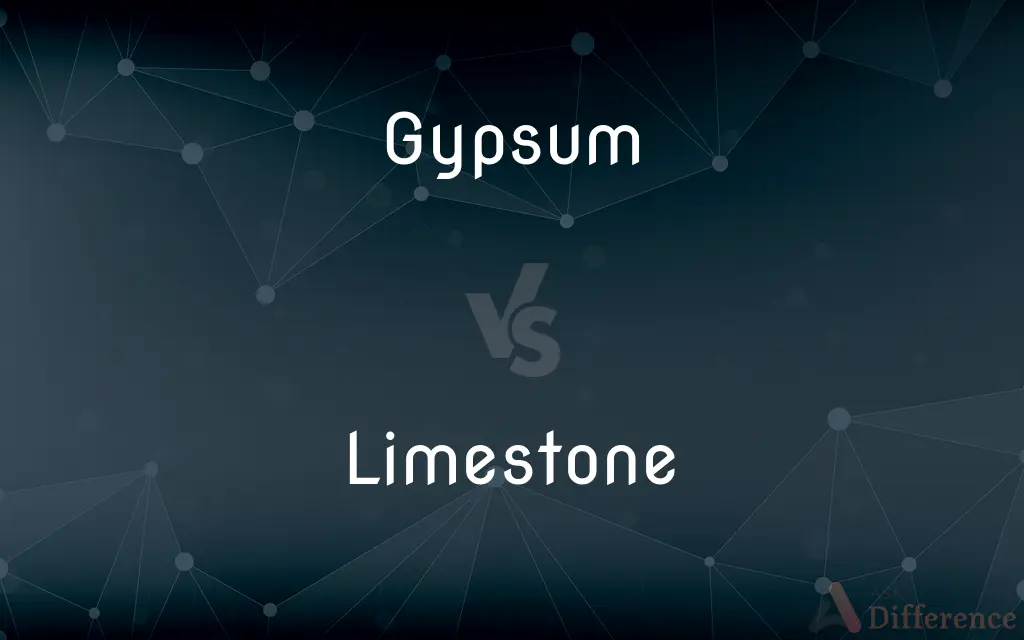Gypsum vs. Limestone — What's the Difference?
Edited by Tayyaba Rehman — By Fiza Rafique — Updated on September 25, 2023
Gypsum is soft sulfate mineral used in construction and agriculture. Limestone is sedimentary rock composed mainly of calcium carbonate used in construction, industry, and agriculture.

Difference Between Gypsum and Limestone
Table of Contents
ADVERTISEMENT
Key Differences
Gypsum: Mineral with chemical formula CaSO4·2H2O. Limestone: Sedimentary rock mainly composed of calcium carbonate (CaCO3).
Gypsum: Softer and less dense than limestone. Limestone: Harder and denser than gypsum.
Comparison Chart
Composition
Soft sulfate mineral (CaSO4·2H2O)
Sedimentary rock primarily of calcium carbonate (CaCO3)
Hardness/Density
Softer, less dense
Harder, denser
Usage
Drywall, plaster, soil conditioner
Construction, cement, agriculture, industry
ADVERTISEMENT
Formation
Often in evaporite deposits
Accumulation of marine shells
Appearance
White or colorless in pure form
Various colors and textures
Compare with Definitions
Gypsum
Soft sulfate mineral used in construction.
Gypsum is a key ingredient in making drywall.
Limestone
Essential in cement production.
Limestone plays a vital role in making concrete.
Gypsum
Soil conditioner to improve plant growth.
Farmers use gypsum to enhance soil quality.
Limestone
Sedimentary rock rich in calcium carbonate.
Limestone is widely used in building materials.
Gypsum
Gypsum is a soft sulfate mineral composed of calcium sulfate dihydrate, with the chemical formula CaSO4·2H2O. It is widely mined and is used as a fertilizer and as the main constituent in many forms of plaster, blackboard/sidewalk chalk, and drywall. A massive fine-grained white or lightly tinted variety of gypsum, called alabaster, has been used for sculpture by many cultures including Ancient Egypt, Mesopotamia, Ancient Rome, the Byzantine Empire, and the Nottingham alabasters of Medieval England.
Limestone
Limestone is a common type of carbonate sedimentary rock. It is composed mostly of the minerals calcite and aragonite, which are different crystal forms of calcium carbonate (CaCO3).
Gypsum
A widespread colorless, white, or yellowish mineral, CaSO4·2H2O, used in the manufacture of plaster of Paris, various plaster products, and fertilizers.
Limestone
A common sedimentary rock consisting mostly of calcium carbonate, CaCO3, used as a building stone and in the manufacture of lime, carbon dioxide, and cement.
Gypsum
A mineral consisting of hydrated calcium sulphate. When calcinated, it forms plaster of Paris.
Limestone
An abundant rock of marine and fresh-water sediments; primarily composed of calcite (CaCO3); it occurs in a variety of forms, both crystalline and amorphous.
Gypsum
A mineral consisting of the hydrous sulphate of lime (calcium). When calcined, it forms plaster of Paris. Selenite is a transparent, crystalline variety; alabaster, a fine, white, massive variety.
Limestone
Pertaining to or made of limestone.
Gypsum
A common white or colorless mineral (hydrated calcium sulphate) used to make cements and plasters (especially plaster of Paris)
Limestone
A rock consisting chiefly of calcium carbonate or carbonate of lime. It sometimes contains also magnesium carbonate, and is then called magnesian or dolomitic limestone. Crystalline limestone is called marble.
Limestone
A sedimentary rock consisting mainly of calcium that was deposited by the remains of marine animals
Common Curiosities
Is gypsum naturally occurring?
Yes, gypsum forms in nature, often in evaporite deposits.
How does limestone contribute to cement production?
Limestone is a primary ingredient in making cement, serving as a source of calcium.
What is gypsum primarily used for?
Gypsum is used in drywall, plaster, and as a soil conditioner.
What is limestone commonly used in?
Limestone is used in construction, cement, and agriculture.
Where does limestone typically form?
It forms from the accumulation of marine shells and sediments.
Can gypsum be used in agriculture?
Yes, it's used to improve soil structure and plant growth.
Share Your Discovery

Previous Comparison
Boolean vs. Bool
Next Comparison
Jupiter vs. EarthAuthor Spotlight
Written by
Fiza RafiqueFiza Rafique is a skilled content writer at AskDifference.com, where she meticulously refines and enhances written pieces. Drawing from her vast editorial expertise, Fiza ensures clarity, accuracy, and precision in every article. Passionate about language, she continually seeks to elevate the quality of content for readers worldwide.
Edited by
Tayyaba RehmanTayyaba Rehman is a distinguished writer, currently serving as a primary contributor to askdifference.com. As a researcher in semantics and etymology, Tayyaba's passion for the complexity of languages and their distinctions has found a perfect home on the platform. Tayyaba delves into the intricacies of language, distinguishing between commonly confused words and phrases, thereby providing clarity for readers worldwide.
















































